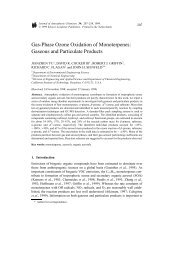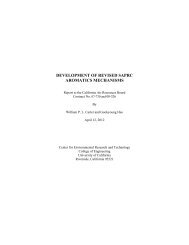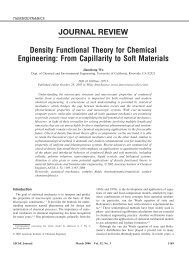Asphaltene precipitation in crude oils: Theory and experiments
Asphaltene precipitation in crude oils: Theory and experiments
Asphaltene precipitation in crude oils: Theory and experiments
Create successful ePaper yourself
Turn your PDF publications into a flip-book with our unique Google optimized e-Paper software.
Table 6. Parameters of the Thermodynamic Model<br />
Parameter* Value Determ<strong>in</strong>ation<br />
Monomer diameter A 1.7 nm Experimental (Buenrostro et al., 2001b), but it can be estimated <strong>in</strong><br />
base of Mw A , molecular density <strong>and</strong> an estimated pack<strong>in</strong>g<br />
fraction.<br />
R 0.5 nm Estimated from density, Mw R , molecular density <strong>and</strong> an estimated<br />
pack<strong>in</strong>g fraction (Wu et al., 2000)<br />
AR Calculate From a comb<strong>in</strong><strong>in</strong>g rule, Eq. A19<br />
Number of<br />
segments<br />
m R 10 Estimated from density, Mw R , molecular density <strong>and</strong> an estimated<br />
pack<strong>in</strong>g fraction (Wu et al., 2000)<br />
(monomers) <strong>in</strong><br />
m A 1 Fixed from model def<strong>in</strong>itions (Wu et al., 1998)<br />
the cha<strong>in</strong><br />
Range of attractive AA Adjustable From <strong>precipitation</strong> <strong>experiments</strong> (see Table 9)<br />
potential RR Adjustable From <strong>precipitation</strong> <strong>experiments</strong> (see Table 9)<br />
AR Calculated From a comb<strong>in</strong><strong>in</strong>g rule, Eq. A20<br />
Bond<strong>in</strong>g volume 0.05 Taken from literature (Fu <strong>and</strong> S<strong>and</strong>ler, 1995; Garcia-Lisbona, 1998;<br />
Gal<strong>in</strong>do et al., 1998b; Gal<strong>in</strong>do et al., 1999)<br />
Hamaker constant H m Calculated Eq. 50 or Eq. 54<br />
H A Adjustable From <strong>precipitation</strong> <strong>experiments</strong> (see Table 9)<br />
H R Adjustable From <strong>precipitation</strong> <strong>experiments</strong> (see Table 9)<br />
Association energy AA Adjustable From <strong>precipitation</strong> <strong>experiments</strong> (see Tables 9 <strong>and</strong> 12)<br />
AR Adjustable From <strong>precipitation</strong> <strong>experiments</strong> (see Tables 9 <strong>and</strong> 12)<br />
Number of s A Adjustable From <strong>precipitation</strong> <strong>experiments</strong> (see Tables 9 <strong>and</strong> 12)<br />
association sites s R 1 Fixed from model def<strong>in</strong>itions (Wu et al., 1998)<br />
*A, asphaltenes; R, res<strong>in</strong>s.<br />
u ij<br />
hs r ij ; ij <br />
r ij ij<br />
0 r ij <br />
(2)<br />
ij<br />
whereas the attractive <strong>in</strong>teraction has an energy depth ij <strong>and</strong><br />
shape ij (r ij ; ij ), where ij is a parameter related to the range<br />
of the attractive forces. The generic potential given by Eq. 1<br />
depends on three parameters: ij <strong>and</strong> ij are the usual length <strong>and</strong><br />
energy parameters, <strong>and</strong> ij is the attractive potential range. By<br />
chang<strong>in</strong>g ij , the shape of the attractive well is modified. To<br />
study the effect of the <strong>in</strong>teraction potential model on <strong>precipitation</strong><br />
results, we used the square well (SW) <strong>and</strong> Sutherl<strong>and</strong> (S)<br />
models for ij<br />
<strong>and</strong><br />
ij<br />
SW r ij ; ij 1<br />
if ij r ij ij ij<br />
0 if r ij ij <br />
(3)<br />
ij<br />
S ij r ij ij /r ij ij (4)<br />
respectively. To estimate the energy parameter ij ,Wuetal.<br />
(1998, 2000) applied an approximation relat<strong>in</strong>g ij with the<br />
Hamaker constant (Israelachvili, 1991), assum<strong>in</strong>g that the medium<br />
(that is, solvent) affects the phase behavior of an asphaltene-conta<strong>in</strong><strong>in</strong>g<br />
<strong>crude</strong> oil only through its Hamaker constant,<br />
imj H 1/ 2 1/<br />
ii H 2 1/<br />
m H 2 1/<br />
jj H 2 m <br />
2 0 0 (5)<br />
i j<br />
where i 0 <strong>and</strong> j 0 correspond to the number density of pure<br />
component of the species i <strong>and</strong> j, <strong>in</strong> terms of the spherical<br />
segments; H ii <strong>and</strong> H jj are the Hamaker constants of the species<br />
i <strong>and</strong> j; <strong>and</strong> H m is the Hamaker constant of the medium, which<br />
depends on its properties, as expla<strong>in</strong>ed below <strong>in</strong> the section<br />
Parameters of the Model. In Eq. 5, ij , which corresponds to its<br />
value <strong>in</strong> vacuum (Eq. 1), has been replaced by its value <strong>in</strong> the<br />
presence of a solvent ( imj ), to consider screen<strong>in</strong>g effects<br />
caused by the cont<strong>in</strong>uous medium m.<br />
Equation of state<br />
The general form of the Helmholtz free energy for associat<strong>in</strong>g<br />
cha<strong>in</strong> molecules (Chapman et al., 1989, 1990) is given by<br />
A<br />
NkT AIDEAL<br />
NkT AM<br />
NkT ACHAIN<br />
NkT AASSOC<br />
NkT<br />
where A is the Helmholtz free energy for an oil of N molecules<br />
at temperature T; k is the Boltzmann constant, <strong>and</strong> A IDEAL , A M ,<br />
A CHAIN , <strong>and</strong> A ASSOC are the ideal-gas, monomer, cha<strong>in</strong>-formation,<br />
<strong>and</strong> association contributions to the free energy, respectively.<br />
In the SAFT-VR approach, improved expressions to<br />
represent the contributions to the free energy ascribed to dispersion<br />
<strong>and</strong> associat<strong>in</strong>g <strong>in</strong>teractions are considered. In Appendix<br />
A the SAFT-VR expressions for the free energy contributions<br />
of Eq. 6 are given <strong>in</strong> detail.<br />
Parameters of the Model<br />
The parameters of our asphaltene <strong>precipitation</strong> thermodynamic<br />
model are the molecular geometry of the solutes <strong>and</strong> the<br />
strength <strong>and</strong> range of their <strong>in</strong>teractions. These parameters are<br />
summarized <strong>in</strong> Table 6 <strong>and</strong> are described <strong>in</strong> this section.<br />
<strong>Asphaltene</strong> <strong>and</strong> res<strong>in</strong> parameters<br />
In this study, the asphaltene monomer diameter A was<br />
experimentally determ<strong>in</strong>ed by a fluorescence depolarization<br />
technique for a Mexican asphaltene, as described elsewhere<br />
(Buenrostro-Gonzalez et al., 2001b). By means of this technique,<br />
average gyration diameters from 12 to 24 Å were<br />
estimated for asphaltenes (Groenz<strong>in</strong> <strong>and</strong> Mull<strong>in</strong>s, 2000). This<br />
(6)<br />
AIChE Journal October 2004 Vol. 50, No. 10<br />
2559
















